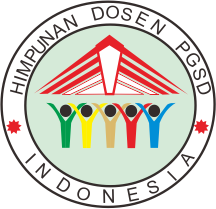PENGEMBANGAN MEDIA PEMBELAJARAN HOLOGRAM 3D BERBASIS ANDROID PADA PEMBELAJARAN IPA UNTUK MENINGKATKAN HASIL BELAJAR SISWA KELAS 5 SDN WONOSARI 01 KOTA SEMARANG
DOI:
https://doi.org/10.23969/jp.v9i3.14534Keywords:
learning media, 3D holograms, science learningAbstract
The use of conventional learning media, such as textbooks for science subjects, reduces students' motivation to participate in lessons. There must be innovation in learning activities, one of which is by using technology such as 3D hologram animation. This research examines the development, testing the feasibility and effectiveness of android-based 3D hologram learning media for 5th grade science learning material on human eye organs. The method used is R&D or development research with the ADDIE research model which has several steps in its research including; analysis (analyze), design (design), development (development), implementation (implementation), and evaluation (evaluation). The results obtained from this study include an assessment of the validation of media experts with a percentage score of 95%, which means that the developed media receives a category that is very feasible to be tested in the science learning process at school. Then the results of media trials using a large scale with a total research population of 23 students conducted in grade 5 SDN Wonosari 01 Semarang City showed an increase in student learning outcomes after the use of hologram learning media. The data on the increase in learning outcomes is supported and evidenced by the results of the N Gain test which obtained an N Gain score with a percentage of 73.89% with an interpretation that it is effective enough to improve the learning outcomes of grade 5 students in science subjects at SDN Wonosari 01 Semarang City.Downloads
References
Abdul Karim, Dini Savitri, & Hasbullah. (2020). Pengembangan Media Pembelajaran Matematika Berbasis Android Di Kelas 4 Sekolah Dasar. Jurnal Lebesgue : Jurnal Ilmiah Pendidikan Matematika, Matematika Dan Statistika, 1(2), 63–75. https://doi.org/10.46306/lb.v1i2.17
Arifudin, A., Kuswandi, D., & Soepriyanto, Y. (2019). Pengembangan Media Obyek 3 Dimensi Digital Sel Hewan dan Tumbuhan Memanfaatkan Piramida hologram Untuk MTS. Kajian Teknologi Pendidikan, 2(1), 9–15.
Ayu, D. P., & Amelia, R. (2020). Pembelajaran Bahasa Indonesia Berbasis E-Learning Di Era Digital. Seminar Nasional Bahasa Dan Sastra Indonesia, 56–61. https://jurnal.umj.ac.id/index.php/SAMASTA/index
Kurniawati, U., & Koeswanti, H. D. (2021). Pengembangan Media Pembelajaran Kodig Untuk Meningkatkan Prestasi Belajar Peserta didik di Sekolah Dasar. Jurnal Basicedu, 5(2), 1046–1052. https://doi.org/10.31004/basicedu.v5i2.843
Maisarah, Ayudia, I., Prasetya, C., & Mulyani. (2023). Analisis Kebutuhan Media Digital Pada Pembelajaran IPA di Sekolah Dasar. Jurnal Pengajaran Sekolah Dasar, 2(1), 48–59. https://doi.org/10.56855/jpsd.v2i1.314
Maisarah, M., & Prasetya, C. (2023). Pengaruh Media Digital Terhadap Keterampilan Proses Sains dan Bernalar Kritis di Sekolah Dasar. Jurnal Basicedu, 7(5), 3118–3130. https://doi.org/10.31004/basicedu.v7i5.6097
Nurhhayati, N. (2022). Penerapan Media Gambar Untuk Meningkatkan Hasil Belajar Ipa Pada Peserta didik Kelas Vi Sdn 011 Sungai Salak. Primary: Jurnal Pendidikan Guru Sekolah Dasar, 11(3), 908. https://doi.org/10.33578/jpfkip.v11i3.8965
Nurrafiah, E. Y., Putra, M. J. A., & Zufriady, Z. (2023). Hubungan Penggunaan Media Piramida Hologram dengan Aktivitas Peserta didik dalam Pembelajaran IPA di Sekolah Dasar. 15. https://doi.org/10.35445/alishlah.v15i4.3148
Peraturan Menteri Pendidikan Dan Kebudayaan Republik Indonesia Nomor 22.Tahun 2016 Tentang Standar Proses Pendidikan Dasar Dan Menengah. 2016. Jakarta Permendikbud
Sugiyono, D. (2018). Metode penelitian kuatintatif, kualitatif dan R &D/Sugiyono. Bandung: Alfabeta.
Undang-Undang Republik Indonesia Nomor 20 tahun 2003 tentang Sistem Pendidikan Nasional. 2003. Jakarta Depdiknas
Downloads
Published
Issue
Section
License
Copyright (c) 2024 Pendas : Jurnal Ilmiah Pendidikan Dasar

This work is licensed under a Creative Commons Attribution 4.0 International License.



















